11-1 Stars form from the gravitational collapse of immense clouds of interstellar gas and dust
Because stars consume their own mass as fuel to power their brilliant shining, stars cannot emit light forever. But, because stars are large, they have quite a bit of mass to use as fuel and can shine for a very long time. Stars last much longer than the lifetime of any astronomer—indeed, far longer than the entire history of human civilization. Thus, it is impossible to watch a single star go through its formation, evolution, and eventual demise. Rather, astronomers have to piece together the evolutionary history of stars by studying different stars at different stages in their life cycles.
ANALOGY
To gain insight into how an astronomer can build a picture of the life cycle of a star, imagine for a moment that you are a biologist from another planet who sets out to understand the life cycles of human beings. You send a spacecraft to fly above Earth and photograph humans in action. Unfortunately, the spacecraft fails after collecting only 20 s of data, but during that time its sophisticated equipment sends back observations of thousands of different humans. From this brief snapshot of life on Earth—only 10−8 (a hundred-millionth) of a typical human lifetime—how would you decide which were the young humans and which were the older ones? Without a look inside our bodies to see the biological processes that shape our lives, could you tell how humans are born and how they die? And how could you deduce the various biological changes that humans undergo as they age?
Astronomers, too, have data spanning only a tiny fraction of any one star’s lifetime. A star like the Sun has enough usable fuel to last for about 10 billion years, whereas astronomers have been observing stars in detail for only about a century. Besides the long time frames, astronomers are further frustrated by being unable to see directly into the hidden interiors of stars. For example, we cannot see the thermonuclear reactions that convert hydrogen into helium. But astronomers have an advantage in that there are many, many stars at different stages in their life cycles to observe. Moreover, stars are made of relatively simple substances, primarily hydrogen and helium, that are found almost exclusively in the form of gases. Of the four basic phases of matter—plasma, gas, liquid, and solid—gases are by far the simplest to understand.
Astronomers use our understanding of gases to build theoretical models of the interiors of stars, like the model of the Sun we saw in Chapter 9. In fact, like all great dramas, the story of stellar evolution can be regarded as a struggle between two opposing and unyielding forces: Gravity continually tries to make a star shrink, while the star’s internal pressure tends to make the star expand. When these two opposing forces are in balance, the star is in a state of hydrostatic equilibrium. But what happens when changes within the star cause either pressure or gravity to predominate? The star must then either expand or contract until it reaches a new equilibrium. In the process, it will change not only in size but also in luminosity and color.
Interstellar Gas and Dust
 Go to Video 11-1
Go to Video 11-1
If stars do not exist forever, then somehow they must come into being. Where do stars come from? As we saw in Chapter 4, stars like our Sun condensed from a collection of gas and dust in interstellar space. Observations suggest that other stars originate in a similar way. In order to pursue the origin of stars, we need to first observe the seemingly empty space between stars.
At first glance, the space between the stars seems to be mostly vacant. On closer inspection, we find that it is filled with a thin gas laced with microscopic dust particles. This combination of gas and dust is called the interstellar medium. Evidence for this medium includes interstellar clouds of various types, curious lines in the spectra of binary star systems, and an apparent dimming and reddening of distant stars.
253
You can see evidence for the interstellar medium with the naked eye. Look carefully at the constellation Orion (Figure 11-1a), easily visible on clear winter nights from the northern hemisphere. While most of the stars in this constellation appear as sharply defined points of light, the middle “star” in Orion’s sword has a fuzzy appearance. This becomes more obvious when viewed through binoculars or a telescope. As Figure 11-1b shows, this “star” is actually not a star at all, but the Orion Nebula—a cloud in interstellar space. Any interstellar cloud is known to astronomers as a nebula (plural nebulae).
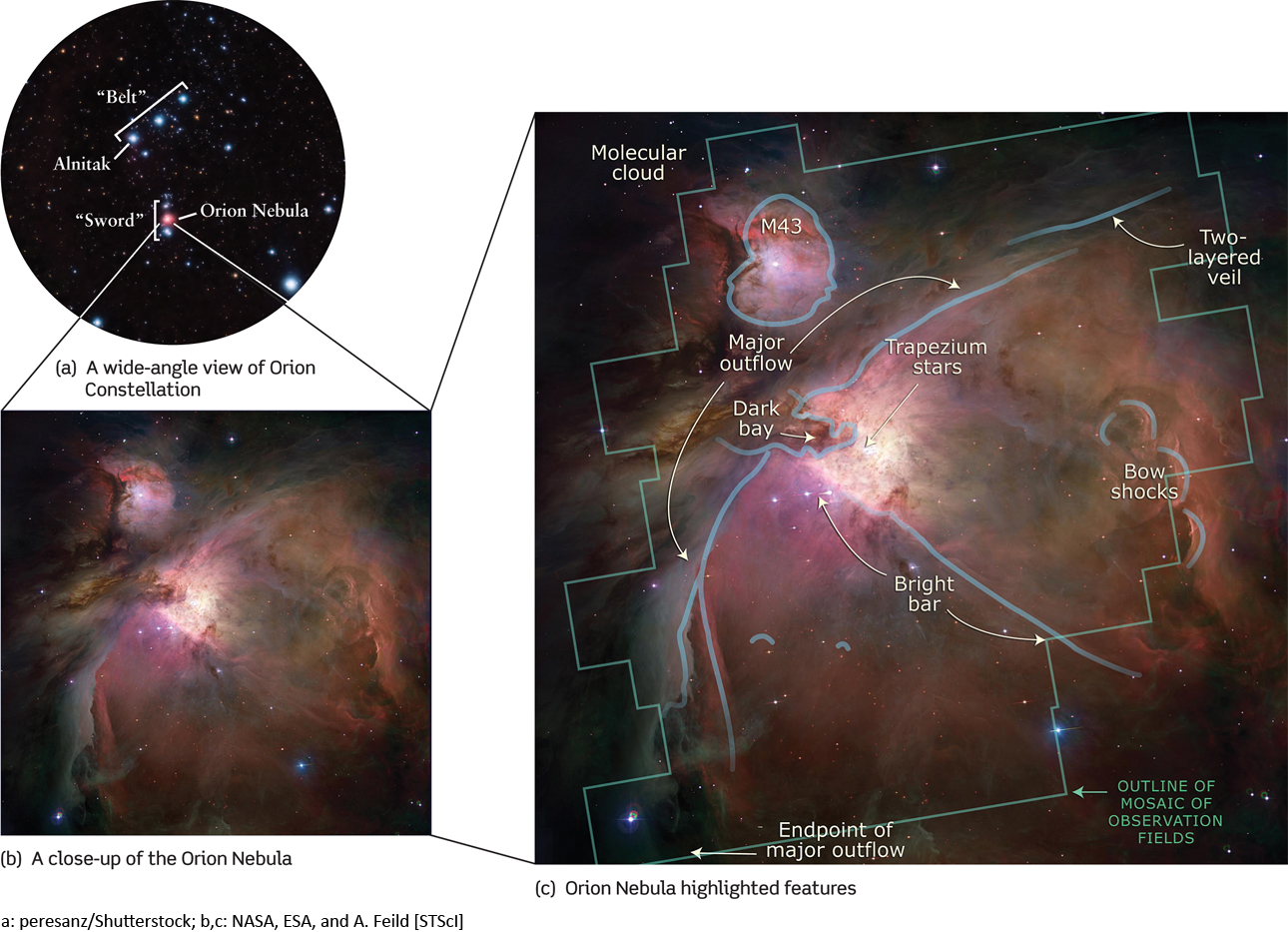
The Orion Nebula emits its own light, with the characteristic emission line spectrum similar to that of a hot, thin gas. For this reason, it is called an emission nebula. Typical emission nebulae are large, having masses that range from about 100 solar masses to about 10,000 solar masses. Because this mass is spread over a huge volume that is light-years across, the density is quite low by Earth standards, only a few thousand hydrogen atoms per cubic centimeter (cm3). (By comparison, the air you are breathing contains more than 1019 atoms per cm3.) Emission nebulae are found near hot, luminous stars of spectral types O and B. Such stars emit copious amounts of ultraviolet radiation. When atoms in the nearby interstellar gas absorb these energetic ultraviolet photons, the atoms become ionized. Indeed, emission nebulae are composed primarily of ionized hydrogen atoms, that is, free protons (hydrogen nuclei) and electrons. These recently ionized atoms are the source of energy emanating from an emission nebula.
In addition to the presence of gas atoms in the interstellar medium, Figure 11-2a shows evidence for large clouds of dust grains. A dark nebula is so opaque that it blocks any visible light coming from stars that lie behind it. Such clouds contain from 104 to 109 particles (atoms, molecules, and dust grains) per cubic centimeter. Although thin by Earth standards, dark nebulae are large enough—typically many light-years deep—that they block the passage of light. In the same way, a sufficient depth of haze or smoke in our atmosphere can make it impossible to see distant mountains.
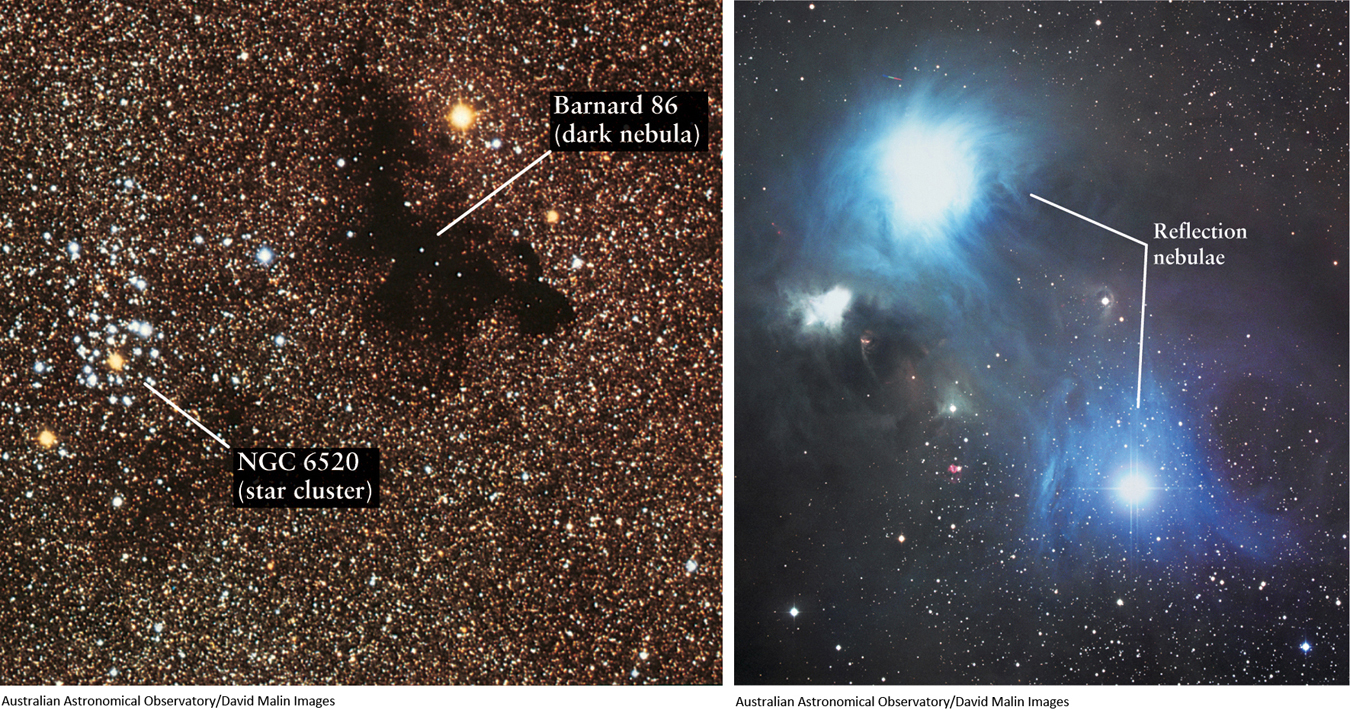
 the angular diameter of the full moon. (b) A wispy reflection nebula called NGC 6726-27-29 surrounds several stars in the constellation Corona Australis (the Southern Crown). Unlike emission nebulae, reflection nebulae do not emit their own light, but scatter and reflect light from the stars that they surround. This scattered starlight is quite blue in color.
the angular diameter of the full moon. (b) A wispy reflection nebula called NGC 6726-27-29 surrounds several stars in the constellation Corona Australis (the Southern Crown). Unlike emission nebulae, reflection nebulae do not emit their own light, but scatter and reflect light from the stars that they surround. This scattered starlight is quite blue in color.
Dark nebulae are enormous clouds of dust and gas that do not allow starlight to pass through.
A different observation that serves as evidence for dust is the bluish haze surrounding the stars in Figure 11-2b. A haze of this kind, called a reflection nebula, is caused by fine grains of dust in a lower concentration than that found in dark nebulae. The light we see coming from the nebula is starlight that has been scattered and reflected by these dust grains. The grains are submicroscopically small, no larger than a typical wavelength of visible light, and they scatter short-wavelength blue light more efficiently than long-wavelength red light. Hence, reflection nebulae have a characteristic blue color, resulting in an effect similar to what causes Earth’s sky to appear blue.
254
Question
ConceptCheck 11-1: What would a reflection nebula become if it could be compressed to 3 times its typical density?
Evolution of a Protostar
Interstellar gas and dust are the raw materials from which stars are made. The disk of our Galaxy, where most of the matter is concentrated, is therefore the site of ongoing star formation. In order for this interstellar material to condense and form a star, the force of gravity—which tends to draw interstellar material together—must overwhelm the internal pressure pushing the material apart. This means that stars will most easily form in regions where the interstellar material is relatively dense, so that atoms and dust grains are close together and gravitational attraction is enhanced. The only parts of the interstellar medium with high enough density and low enough temperature for stars to form are the dark nebulae. Within these clouds, the densest portions can contract under their own mutual gravitational attraction and form clumps called protostars. Each protostar will eventually evolve into a main-sequence star. Because dark nebulae contain many solar masses of material, it is possible for a large number of protostars to form out of a single such nebula. Thus, we can think of dark nebulae as “stellar nurseries.”
Many stars are formed from a single, gigantic collapsing cloud.
At first, a protostar is merely a cool blob of gas several times larger than our solar system. The pressure inside the protostar is too low to support all this cool gas against the mutual gravitational attraction of its parts, and so the protostar collapses. As the protostar collapses, gravitational energy is converted into thermal energy, making the gases heat up and start glowing. Figure 11-3 shows a Hubble Space Telescope observation of a protostar called V838 Monocerotis. This star suddenly brightened for a few weeks, emitting a short burst of light. As that light burst traveled outward, it illuminated each of the surrounding layers of dust for a brief time, one layer at a time. In this picture, we are not actually seeing a movie of previously emitted dust expanding; rather, what we are seeing is light that traveled from the star out to the dust, which was then reflected back to observers here on Earth. Because of the long, indirect path light can take out to where the outermost dust layers are, the reflected starlight arrives at Earth months after light from the star that bounced off of nearby dust layers. This results in a false appearance of expansion, in much the same way medical doctors can look at various layers of a person’s brain using a MRI brain scan.
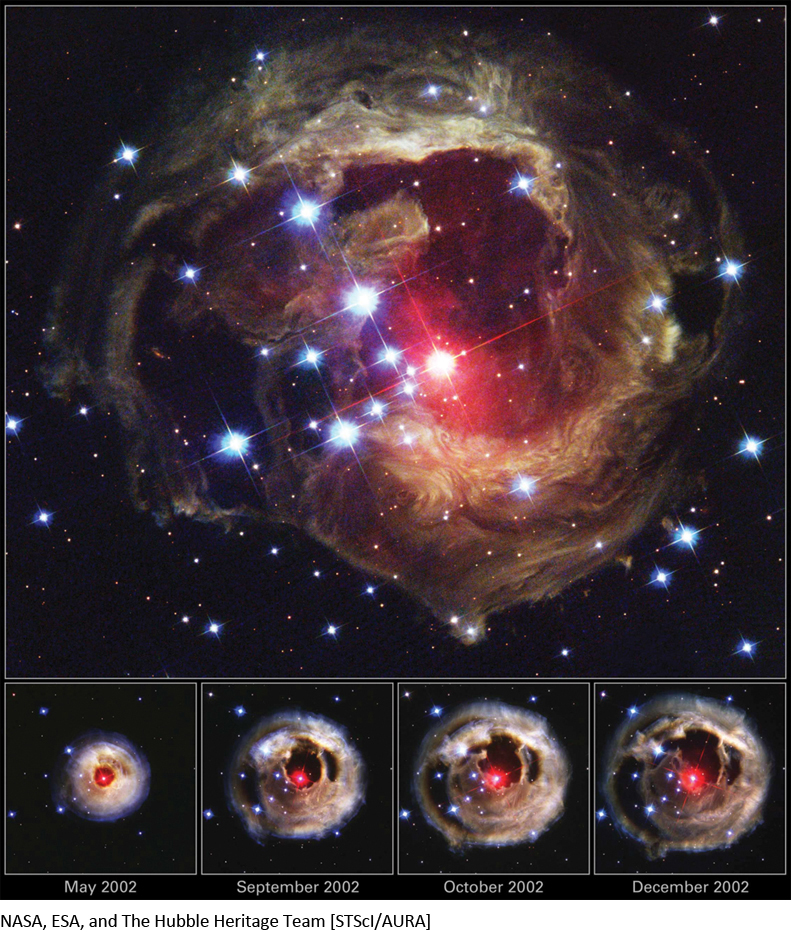
Observing the evolution of a protostar can be quite a challenge. It is quite unlikely that you have ever seen a protostar shining in the night sky because protostars form within clouds that contain substantial amounts of interstellar dust. The dust in a protostar’s immediate surroundings, acting somewhat like a protective moth’s cocoon, absorbs the vast amounts of visible light emitted by the protostar and makes it very hard to detect using telescopes tuned to visible wavelengths.
255
Protostars, however, can be seen hiding inside clouds using infrared telescopes. Because the cloud absorbs so much energy from its central protostar, the dust surrounding a protostar becomes greatly heated to a few hundred kelvins. The warmed dust then reradiates its thermal energy at infrared wavelengths, to which normally opaque dust is relatively transparent. So, by using infrared telescopes, astronomers can see protostars within the “stellar nursery” of a dark nebula.
Figure 11-4 shows visible-light and infrared views of one such stellar nursery, known as the Flame Nebula. The visible-light view (Figure 11-4a) shows a dark, dusty nebula that appears completely opaque. The infrared image (Figure 11-4b) allows us to easily see through the dust, revealing newly formed protostars within the dark nebula.
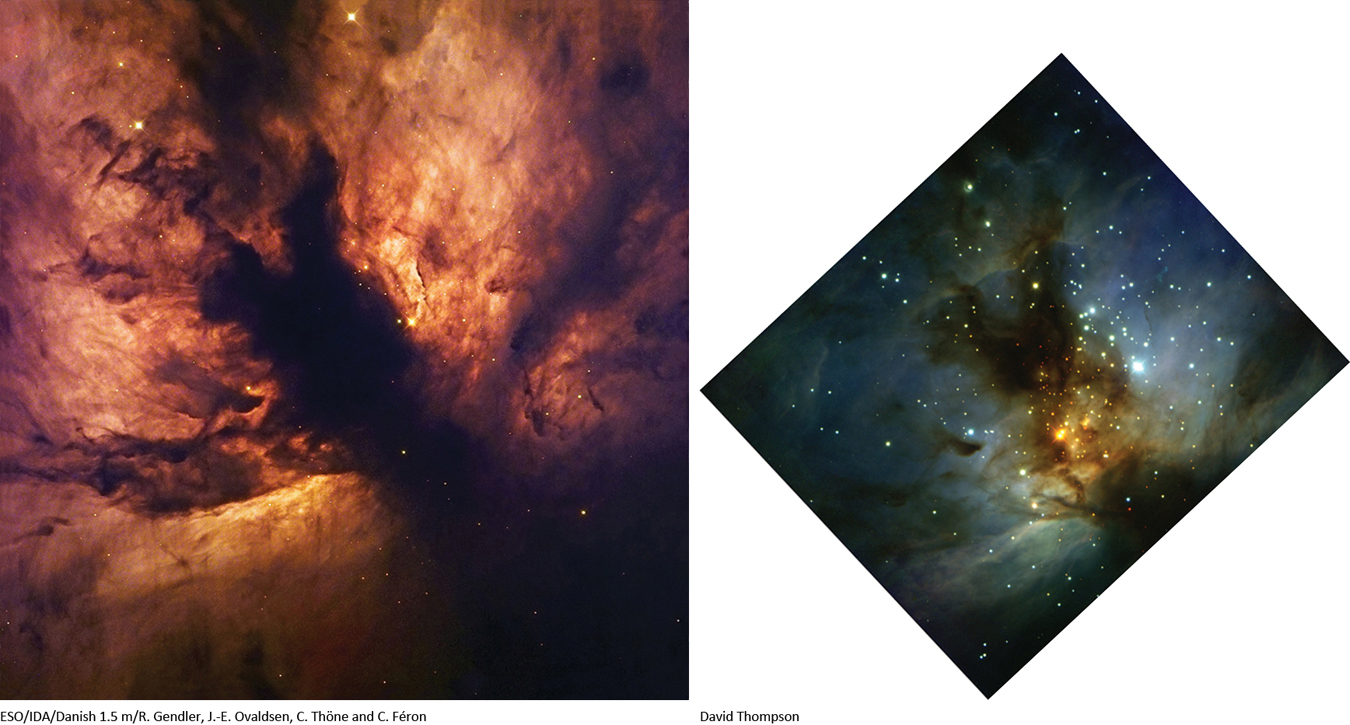
It is reasonable to think that a main-sequence star forms simply by collapsing inward. It might be surprising to learn that much of the material of a cold, dark nebula is ejected into space and never incorporated into stars. As it is ejected, this material may help sweep away the dust surrounding a young star, making the star observable at visible wavelengths.
Mass ejection into space is a hallmark of a particular type of star and can be very dramatic, as captured by the Hubble Space Telescope and shown in Figure 11-5. Known as T Tauri stars, these protostars have emission lines as well as absorption lines in their spectra. Their luminosity can change irregularly on timescales of a few days. The namesake of this class of stars, T Tauri, is a protostar in the constellation Taurus (the Bull).
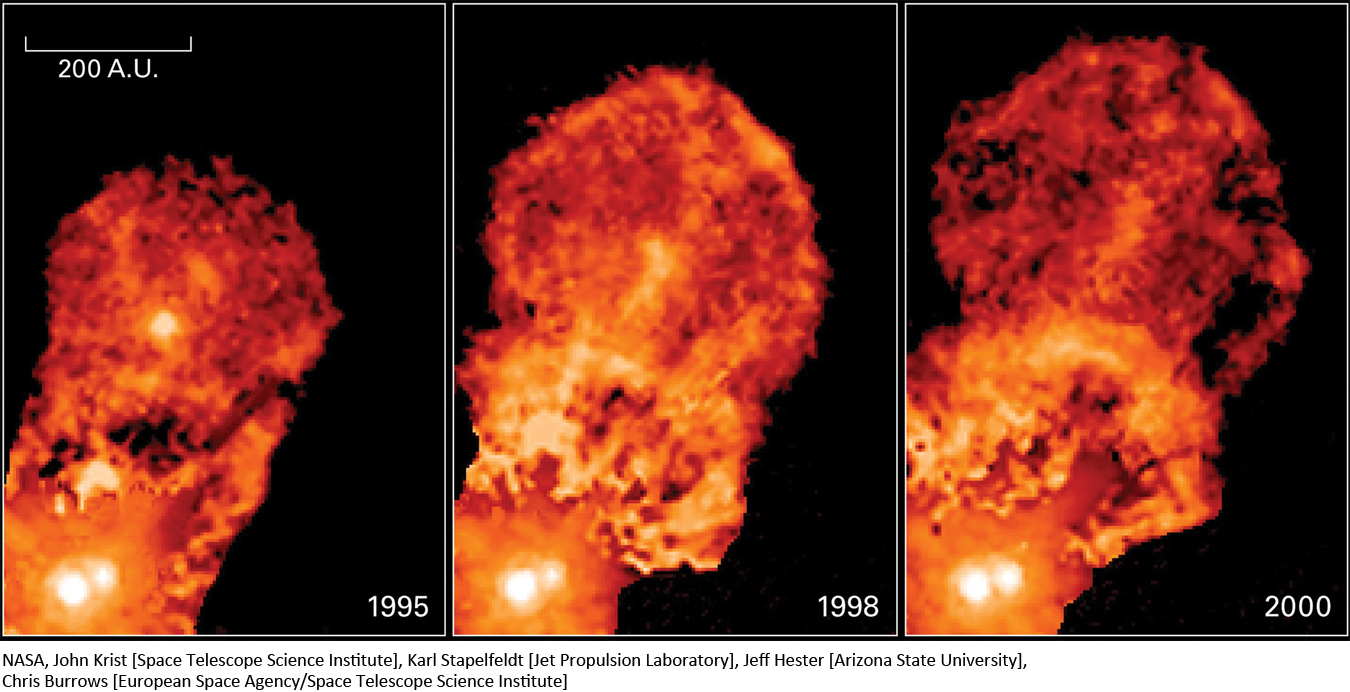
T Tauri stars have masses less than about 3 times larger than the mass of our Sun (written as 3 M⊙) and ages around a million years, so on an H-R diagram, they appear above the right-hand end of the main sequence. The emission lines show that these protostars are surrounded by a thin, hot gas. The Doppler shifts of these emission lines suggest that the protostars eject gas at speeds around 180,000 mi/h (80 km/s).
Protostars are able to slowly add mass to themselves at the same time that they rapidly eject material into space. In fact, the two processes are related. As a protostar’s nebula contracts, it spins faster and flattens into a disk with the protostar itself at the center. The same flattening took place in the solar nebula from which the Sun and planets formed. Particles orbiting the protostar within this disk collide with each other, causing them to lose energy, spiral inward onto the protostar, and add to the protostar’s mass. The resulting disk of material being added to the protostar in this way is known as a circumstellar accretion disk. Figure 11-6 is an edge-on view of one such circumstellar accretion disk, showing one of two oppositely directed jets emanating from a point at or near the center of the disk, where the protostar is located.
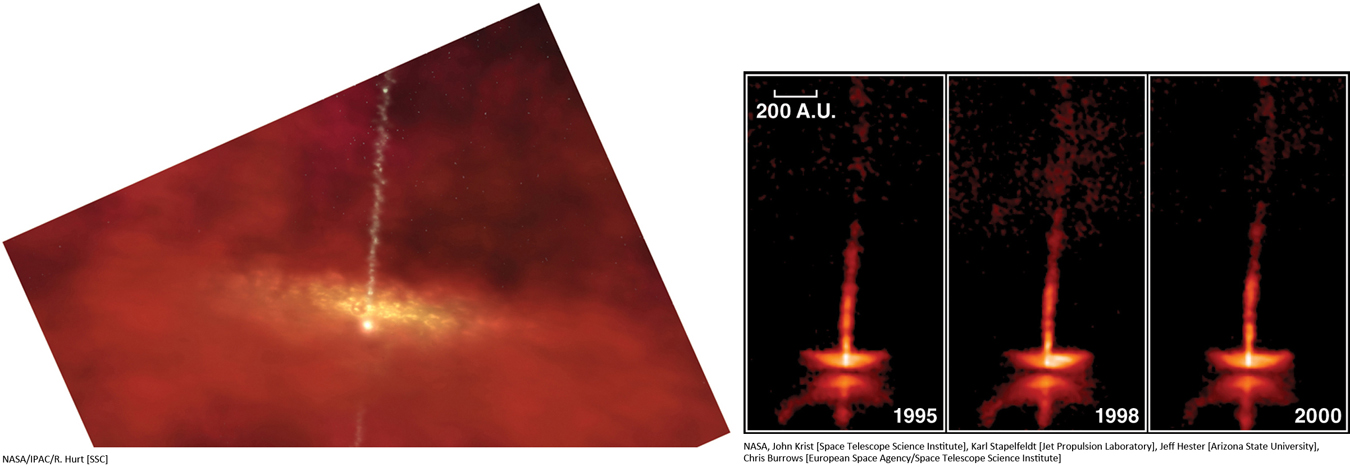
256
In the 1990s, astronomers using the Hubble Space Telescope discovered many examples of disks around newly formed stars in the Orion Nebula (see Figure 11-1 and Figure 4-12b), one of the most prominent star-forming regions in the northern sky. If one imagines that planets can form these dusty disks, then they are appropriately called protoplanetary disks, or proplyds, that surround young stars within the nebula. As the name suggests, protoplanetary disks are thought to contain the material from which planets form around stars.
These protostars can mature into stable main-sequence stars quickly. The speed at which they do so depends entirely on their starting mass. An H-R diagram of protostars, like the one shown in Figure 11-7, shows that a protostar 15 times the mass of our Sun becomes a star in about 100,000 years while a much smaller protostar, like one that is about the same mass as our Sun, can take more than 10 million years to form.
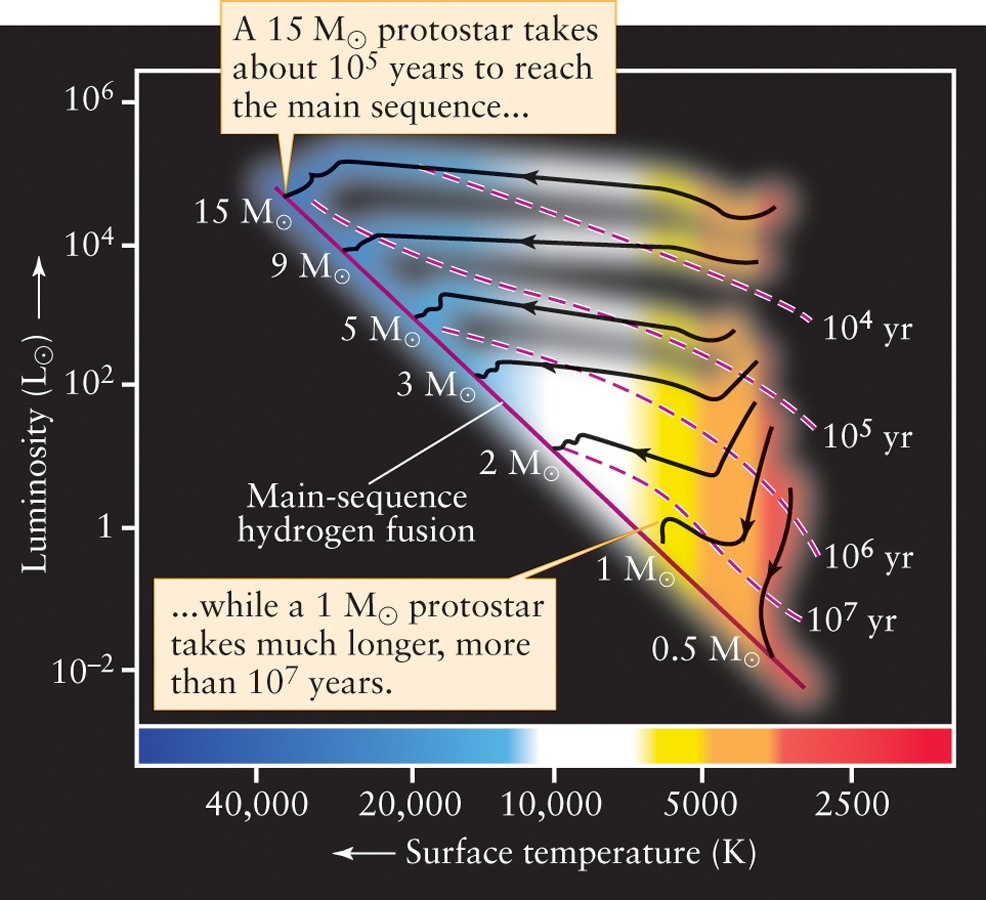
Question
ConceptCheck 11-2: Do protostars increasing in brightness gain mass or eject mass during formation?
Supernovae Can Trigger Star Birth
 Go to Video 11-2
Go to Video 11-2
We will learn in Chapter 14 that a star-filled galaxy’s moving spiral arms can cause clouds to compress and initiate star birth, but this is certainly not the only mechanism for triggering the birth of stars. Presumably, anything that compresses interstellar clouds will do the job. The most dramatic cause is the violent death of a massive star after it has left the main sequence, known as a supernova. As we will see in Chapter 12, the core of the doomed large star collapses suddenly, releasing vast quantities of particles and energy that blow the star apart. The star’s outer layers are blasted into space at speeds of several thousand kilometers per second.
257
Astronomers have found many nebulae across the sky that seem to be the shredded remains of these massive dead stars. Such nebulae, like the one shown in Figure 11-8, are known as supernova remnants. Many supernova remnants have a distinctly circular or arched appearance, as would be expected for an expanding shell of gas. This wall of gas is typically moving away from the dead star faster than sound waves can travel through the interstellar medium. Such supersonic motion produces a shock wave that abruptly compresses the medium through which it passes. When a gas is compressed rapidly, its temperature rises, and this temperature rise causes the gas to glow, as shown in Figure 11-8.
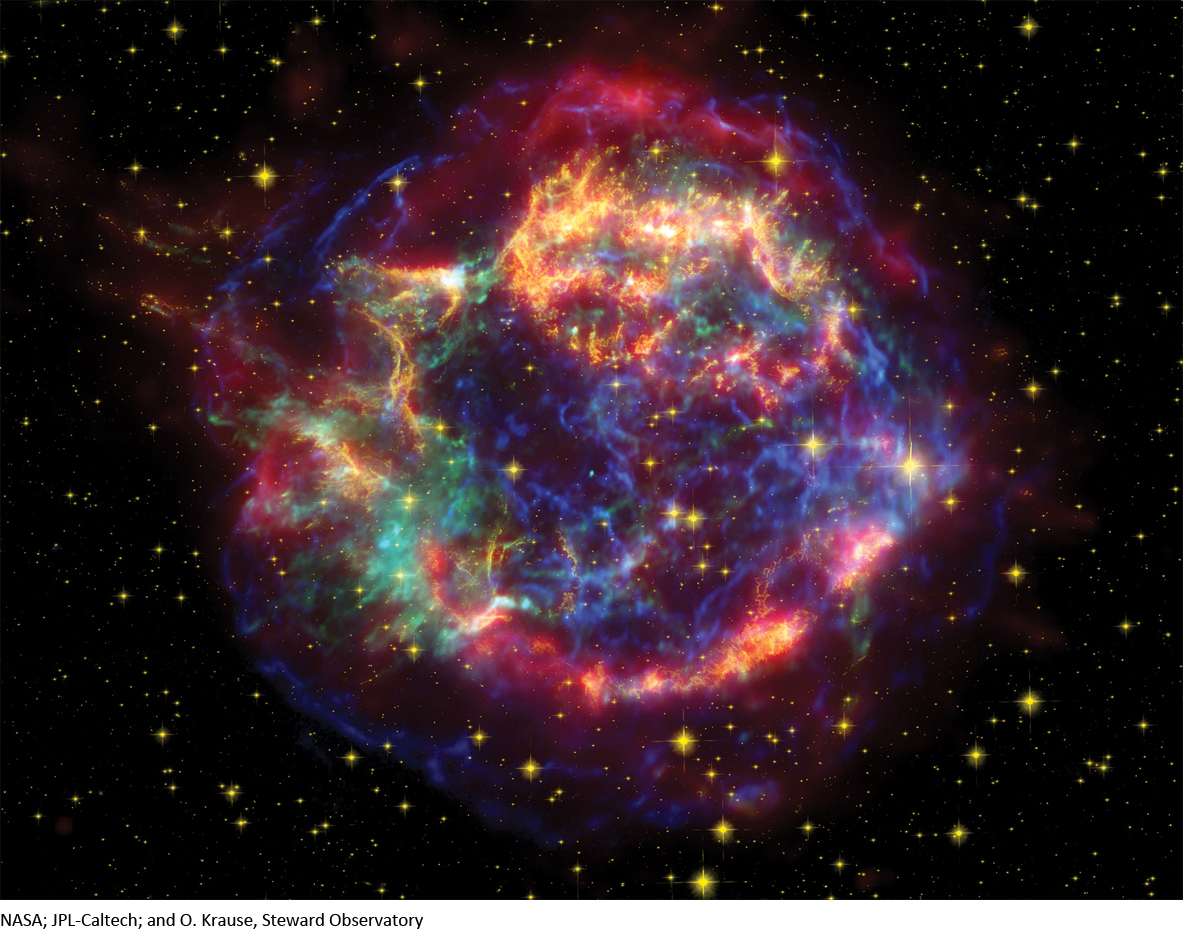
When the expanding shell of a supernova remnant slams into an interstellar cloud, it squeezes the cloud, stimulating star birth, as illustrated in Figure 11-9. This kind of star birth is taking place in the stellar nursery seen in Figure 11-9d. This stellar nursery is located along an arch of glowing gas that is presumably the remnant of an ancient supernova explosion. There are certainly other compression processes available to trigger star formation. For example, a collision between two interstellar clouds can create new stars. Compression occurs at the interface between the two colliding clouds and vigorous star formation follows. Similarly, intense stellar winds from a group of hot O and B stars may exert strong enough pressure on interstellar clouds to cause compression, followed by star formation.
258
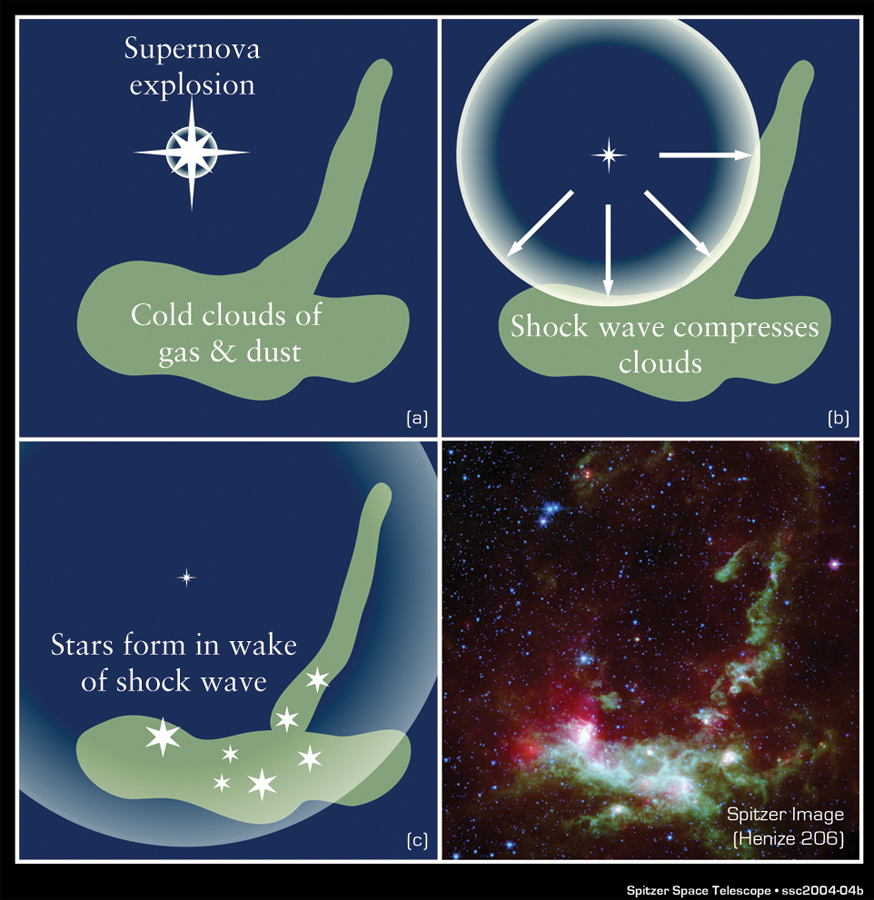
Question
ConceptCheck 11-3: What physical process is needed to initiate the formation of a star?